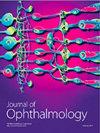青光眼疑似患者的稳态模式视网膜电图和汉弗莱视野分析仪全局指数及其与视网膜神经节细胞层-内层丛状层厚度的相关性
IF 1.8
4区 医学
Q3 OPHTHALMOLOGY
引用次数: 0
摘要
研究目的本研究旨在探讨稳态模式视网膜电图(ss-PERG)在检测 24-2 汉弗莱视野(HFA)正常的青光眼疑似患者(GS)视网膜神经节细胞(RGC)功能障碍方面的实用性。材料和方法。这是一项前瞻性队列研究,研究对象是根据视盘外观和正常汉弗莱视野确定的青光眼患者。患者接受了全面的眼部检查、标准自动周边测量(SAP)、光学相干断层扫描(OCT)和ss-PERG测量。研究了ss-PERG参数,即Magnitude (Mag)、Magnitude D (MagD)和MagD/Mag比值,以及它们与HFA和OCT测量之间的关系。结果。本研究共纳入 25 名患者,共计 49 只眼睛。15 只眼睛的ss-PERG参数异常,与ss-PERG参数正常的GS眼睛相比,HFA 24-2、视网膜神经纤维层(RNFL)厚度、神经节细胞层和内丛状层(GCL + IPL)厚度存在显著差异。在控制了年龄、性别、眼压、中央角膜厚度和球面等值之后,所有ss-PERG参数都与24-2 VF平均偏差(MD)和视野指数(VFI)以及10-2 VF MD显著相关。在控制了年龄、球面等值和眼压后,MagD/Mag 比值对 GCL + IPL 平均厚度的差异有显著影响,而 24-2 VF MD 和 10-2 VF MD 则没有。MagD/Mag 比值也在很大程度上导致了所有黄斑 GCL + IPL 扇形的差异,而 10-2 VF MD 则没有。结论:ss-PERG 与 HFA 全局指数有明显的相关性,并能预测 GS 患者的 GCL + IPL 厚度。ss-PERG可作为一种有用的功能性工具,用于检测和测量GS患者的RGC功能障碍。在检测 GCL + IPL 厚度的早期变化方面,ss-PERG 似乎比 HFA 更为敏感,与当前的诊断研究结合使用可能有助于提高监测 GS 进展的能力。本文章由计算机程序翻译,如有差异,请以英文原文为准。
Correlations between Steady-State Pattern Electroretinogram and Humphrey Visual Field Analyzer Global Indices and Their Associations with Retinal Ganglion Cell Layer-Inner Plexiform Layer Thickness in Glaucoma Suspects
Purpose. The purpose of this study was to investigate the utility of steady state pattern electroretinogram (ss-PERG) in detecting retinal ganglion cell (RGC) dysfunction in glaucoma suspects (GS) who had normal 24-2 Humphrey Visual Fields (HFA). Materials and Methods. This was a prospective cohort study of GS patients who were identified based on optic disc appearance with normal HFAs. Patients received a complete eye examination, standard automated perimetry (SAP), optical coherence tomography (OCT), and ss-PERG measurements. The ss-PERG parameters, Magnitude (Mag), Magnitude D (MagD), and MagD/Mag ratio, were examined, along with their relationships between HFA and OCT measurements. Results. Twenty-five patients were included in this study, with a total of 49 eyes. Fifteen eyes had abnormal ss-PERG parameters and when compared to GS eyes with normal ss-PERG parameters, there were significant differences in HFA 24-2, retinal nerve fiber layer (RNFL) thickness, and ganglion cell layer and inner plexiform layer (GCL + IPL) thickness. All ss-PERG parameters were significantly correlated with 24-2 VF mean deviation (MD) and visual field index (VFI), as well as 10-2 VF MD after controlling for age, sex, intraocular pressure, central corneal thickness, and spherical equivalent. When controlled for age, spherical equivalent, and IOP, MagD/Mag ratio significantly contributed to the variance in average GCL + IPL thicknesses, whereas 24-2 VF MD and 10-2 VF MD did not. MagD/Mag ratio also significantly accounted for variance in all macular GCL + IPL sectors, while 10-2 VF MD did not. Conclusions. ss-PERG has significant correlations with HFA global indices and was predictive of GCL + IPL thickness in GS patients. Clinical Significance. ss-PERG may serve as a useful functional tool for detecting and measuring RGC dysfunction in GS. It appears to be more sensitive than HFA in the detection of early changes in GCL + IPL thicknesses and may be helpful to use in conjunction with current diagnostic studies to improve the ability of monitoring GS progression.
求助全文
通过发布文献求助,成功后即可免费获取论文全文。
去求助
来源期刊

Journal of Ophthalmology
MEDICINE, RESEARCH & EXPERIMENTAL-OPHTHALMOLOGY
CiteScore
4.30
自引率
5.30%
发文量
194
审稿时长
6-12 weeks
期刊介绍:
Journal of Ophthalmology is a peer-reviewed, Open Access journal that publishes original research articles, review articles, and clinical studies related to the anatomy, physiology and diseases of the eye. Submissions should focus on new diagnostic and surgical techniques, instrument and therapy updates, as well as clinical trials and research findings.
 求助内容:
求助内容: 应助结果提醒方式:
应助结果提醒方式:


